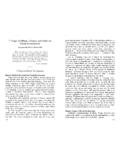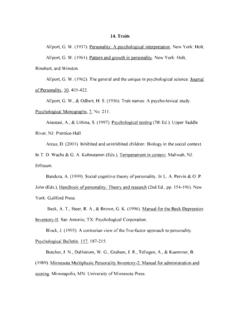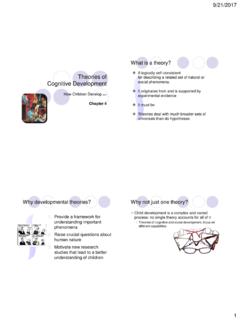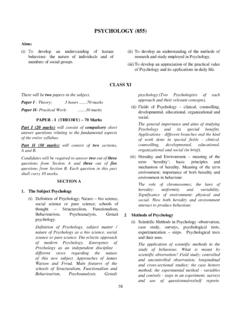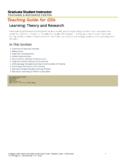Transcription of 4. Piaget and Cognitive Development
1 4. Piaget and Cognitive Development did become interested in studying the way that children reasoned when attempting to solve the problems presented to them by the tests. Often it was the child's production of incorrect answers that Copyright 2004, James Fleming, intrigued Piaget , and in attempting to discover how the children _____ arrived at their answers, he embarked on a lifelong journey of studying the stages and growth of cognition in children. He was During this [early childhood] period magic, animism, and primarily interested in how children think, and how their thinking artificialism are completely merged. The world is a society of living beings controlled and directed by man. The self and the about solving problems changes qualitatively at different stages of external world are not clearly delimited.
2 Every action is both Development . physical and psychical. Although Piaget 's early writings received some attention in the Jean Piaget1. _____ United States in the 1920s and 1930s, his influence waned with the rise of behaviorism. His research did not mesh well the methodological paradigms of his time, nor with the behavioristic Piaget 's Place in the History of Psychology ideas that were prevalent. Although Piaget did study behavior by direct observation, his ideas were perhaps too mentalistic for that A ranking of the most eminent psychologists of the 20th that era roughly the twenties through the fifties. Also, he often century by professionals in the field listed the top three names as based his observations on very small and somewhat biased samples B.
3 F. Skinner, Jean Piaget , and Sigmund Freud (Haggbloom and including his own children! These factors raised questions about others, 2002). These three names also occupy places of his objectivity: to American psychologists his methods were more prominence in this textbook. But although Skinner's impact on the like clinical observations or case studies than rigorous, scientific, field of psychology was enormous, interest in the kind of laboratory kinds of procedures. Yet his observations have been behaviorism he espoused has waned; and though many of Freud's verified in scientific research many times over. According to contributions still influence the theory and practice of psychology, Wadsworth these criticisms of Piaget 's methodology diminish in many of his major ideas have been duly rejected by his successors.
4 Importance if one accepts the assumption implicit in Piaget 's Of these three psychologists, Piaget 's ideas have probably fared theory: that the general course of Development of intellectual the best over the years: they continue to influence research and structures is the same for all people (1996, p. 9). But remember, theory in child Development , and with some minor exceptions, his Piaget was first a biologist; he believed that human behavior is theories have stood the crucial test of time as well as any major adaptive; and further, that the general patterns of adaptation theorist in psychology. Yet Piaget was not a psychologist by equally characterized all members of our species in the process of formal training. His two doctorates were in natural science Development .
5 And why not? Except in the rarest of anomalies, a (emphasizing biology; his early interests were in studying biologist studying the digestive system of one member of a species mollusks) and philosophy (emphasizing logic). But Piaget had would expect that the anatomic and physiological principles would many interests, including epistemology and the philosophy of be the same in all other members of that species. Why shouldn't science, both of which influenced his research. the same be said of basic psychological principles of growth and In 1920, Piaget had an opportunity to work with Theodore Development as well, grounded as they are in biology? Simon (who was the co-creator of the first intelligence test, along with Alfred Binet; Binet & Simon, 1905).
6 Piaget found his job of helping to standardize intelligence tests rather uninteresting, but he 4- 1 4- 2. Basic Piagetian Concepts Piagetian Conservation Tasks Piaget : Some Biographical Facts Before plunging headlong into Piaget 's sometimes abstract theoretical ideas about the ways in which children learn at different Piaget had his first publication at age 10 in a nature stages of Development , it may be helpful particularly to students magazine, on an albino sparrow. with no familiarity with Piaget to begin with a few examples of his well-known conservation tasks. These nicely illustrate Piaget 's Between 15 and 18 years of age, he published a series of approach to observing children as they grapple with ordinary articles on shellfish.
7 As a result, he was offered a position as objects. curator of the mollusk collection at the Geneva museum of Piaget noticed that students below a certain level of maturity natural history. (He had to turn this down because he had yet (prior to about age seven) had difficulty in comprehending certain to finish high school!) problems involving invariants in quantity. In his famous water level task, for instance (see Fig. ), a child is shown a large glass Piaget received his PhD in natural science at age 21 from the or pitcher of water. The water is poured into a different size University of Neuch tel. By this time he had already container one that is wider so that the resulting water level is published 21 papers! lower than it was for the original container.
8 Young children simply did not see that the amount of water was unchanged. They might His interest in epistemology (theory of knowledge) led him to report that the glass with the lower level has less water, because study how children solve problems. the height is lower, or less commonly, that there is more water in the glass with the lower level because it is more spread out. At Albert Einstein's suggestion, Piaget investigated Similarly, if a large lump of clay is broken into several smaller children's understanding of time, space, speed, and motion, lumps, the child may claim that there is now more clay, because resulting in two books on these subjects. the number of lumps has increase, or perhaps that there is less clay, because the lumps are smaller.
9 Or, if the large lump of clay is During his long lifetime ( Piaget died in 1980, at age 84) he flattened, they likewise believe that the amount has changed wrote over 40 books and numerous articles. He was honored simply because of the change in shape of the mass. In these, and in by the American Psychological Association with the other tasks illustrated in Figure , the child fails to see that the Distinguished Scientist Award in 1969. amounts are the same: that the quantities are preserved or conserved under these transformations ( , they do not actually (For more information concerning Piaget 's life and achievements, change, even though their appearances change). see Ginsburg and Opper, 1988.) Piaget called the stage of Development just before children reach the level where they can correctly solve the conservation tasks the preoperational stage (see Table ).
10 At this stage, children seem to have difficulty focusing on more than one aspect of a situation. He called this tendency to focus on just a single aspect of a situation centration. For example, the child's attention 4- 3 4- 4. may be centered primarily on the height of the water level, yet the Generality. Each period can be described by very general child fails to see that the width also changes, and compensates for properties. Thus, for example, the concrete operational period is the lowered height. A key feature of the preoperational stage is that not merely the period in which a child can solve water level the child's thinking process precludes the notion of reversibility in problems, but more generally, the child has come to understand the these mental operations: he or she cannot seem to grasp the notion concept of conservation, including reversibility, as well as the loss that conservation requires (mentally) seeing that pouring the water of centration.
